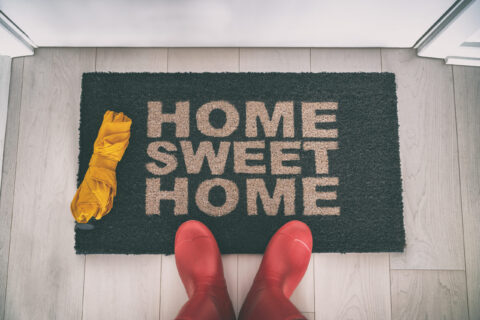If you are considering moving to a hot environment, we’ll discuss the pros and cons of both cold and hot climates. If you’re ready to commit, we have some tips to help you make the most of your move and acclimate to your new home. Let’s dive in.
Living in a Warm Climate vs Cold Climate: What’s the Difference?
If you’ve ever spent a February in the Midwest, you’ve probably spent a dreary day longing for sunshine and warmth. However, both cold and warm climates have their advantages and disadvantages. So, let’s break them down before you start migrating south.
Warm Climates: What to Know When Moving to a Hot Environment
Pros:
- You’ll get plenty of vitamin D.
- You’ll likely spend more time outdoors. Although running in hot, humid weather can be uncomfortable, you’re more likely to head out for outdoor activities when you don’t have to bundle up first.
- Your brain will thank you—spending time in the sun boosts serotonin, a chemical your brain and gut produce that improves your mood.
- A smaller wardrobe and less packing. Donate your bulky winter coats, gloves and scarves, and pack a little more lightly.
Cons:
- There are more annoying insects like mosquitoes for longer periods of the year.
- It’s challenging to avoid skin damage and sunburn. When you move to a warm climate, you’ll need to be extremely mindful of protection. Wear sunscreen and sun hats.
- Continuous heat can take a toll on your mind and body. Even if you enjoy warmer climates, everyone needs a break sometimes. When you live somewhere that’s warm year-round, it can be tough to escape the heat.
- You may experience a heat-related illness or heat cramps. If you don’t follow appropriate steps, your body can have a hard time adjusting. It’s important to do your best to stay cool and drink plenty of fluids!
Cold Climates: What to Know When Moving to a Cold State
Pros:
- You may have an increased metabolic rate. When our body is cooler, it has to work harder to maintain our core body temperature.
- There’s a strong sense of community. “Midwest nice” probably evolved out of harsh winters. When the weather is freezing and the snow starts to pile up, there’s often support and kindness between folks in the community.
- Healthier skin. Without the sun’s harsh rays, you’re less likely to experience redness and swelling.
Cons:
- Unsafe road conditions. When temperatures dip below freezing, roads can quickly become icy. If you’re uncomfortable driving in snow, ice or slush, a cold-weather home may not be for you.
- Sedentary lifestyle. It can be tough to build up the courage to head out to the gym when the roads are slick or out for a run when there’s snow on the sidewalk. That’s why long seasons of cold weather can often lead to a sedentary lifestyle.
- Heating your home can lead to high energy costs. Of course, this difference may vary, as you may spend the same amount on air conditioning costs.
Does Moving to a Warmer Climate Improve Mood?
Moving to warmer climates often means spending more time outside and enjoying more days of sunshine, both of which can improve mental well-being. Spending time in nature can help us concentrate more effectively, boost creativity, decrease anxiety and provide many other health benefits. More sunshine can also help alleviate seasonal affective disorder.
Does Your Body Acclimate to Hot Climates?
Yes. As you expose your body to hotter weather over time, it will become accustomed to higher temperatures. To acclimate to hotter climates, it’s important to gradually and slowly increase your exposure to heat to avoid the potential risks of heat-related illnesses like heat exhaustion or heat stroke.
How to Acclimate to Hot Weather: 6 Tips
So, how do cold or temperate weather folk acclimate to hot climate states? We’ve got six essential warm-weather tips that you can easily implement.
1. Stay Hydrated: You’ll Sweat More Than Usual
The hotter it is, the more you sweat—especially when your body isn’t used to the heat. Make sure you have plenty of water, a reusable water bottle nearby and maybe even take a few cold showers! Once your body gets used to the heat, your sweat production will slow down.
2. Be Financially Mindful: Your Summer Energy Bills Will Increase
If you’re relocating from a temperate climate like Washington or Oregon, you likely used air conditioning for only a few months. In hot climate states, you’ll want to use air conditioning like you used the furnace, and that can be expensive. To keep your A/C use efficient, follow these tips:
- Whether it’s central air or a window unit, it’s important to inspect the condition of your current air conditioning equipment and determine if it’s energy efficient.
- Watch out for things like leaky windows and cracks under the door. Your home should be well-insulated to maximize energy efficiency.
- Keep curtains closed to minimize sunlight, or invest in window shades or UV-filtering window tints.
On the bright side, your winter energy bills will be much less than you’re used to. For example, the average temperature in Arizona during January is around 67° — which beats those cold Midwestern winters!
3. Change Your Routine: The Heat & Sun Will Make a Big Impact on Your Day
If you’re used to heading out for a run after work, you may want to think about shifting your routine. In your new hot climate, being active outside when the sun is intense and temperatures are high can prove dangerous.
Keep your run fun and safe by going early in the morning when the day is at its coolest. Avoid using your oven or doing laundry during the day, as these appliances quickly heat up your home. You may even want to build an outdoor kitchen area, which is much more common in the southern U.S. than in northern states.
4. Cover Your Windshields: Your Car Will Feel Like a Furnace
Parking your car in the sun on a hot day can transform your formerly air-conditioned vehicle into what feels like the inside of a pizza oven. Covering your car’s windshield with a reflective cover can help limit how hot your car gets and prevent metal components, like your seat belt, from burning you. You can also protect your steering wheel with a light-colored, heat-resistant fabric covering.
5. Help Your Pets Adjust: They’ll Notice the Difference, Too!

When moving to one of the hottest cities in the US, your pets need time to adjust, too. Combat the effect of hot weather on your pets by:
- Bringing pets inside during extreme heat
- Taking them on walks in the early morning or evening
- Providing plenty of shade in your yard
- Giving them access to fresh drinking water
- Providing access to a small pool or tub
- Being mindful of pavement — if concrete or asphalt is too hot for your hand, it’s too hot for your pup’s paws.
6. Wear Sunscreen: Your Skin Will Need Extra Protection
While your mind might appreciate the increased sunshine, your skin needs protection. How much sun exposure is too much depends on your skin tone, but applying sunscreen and wearing hats and sunglasses is a good way to limit harmful UV rays for everyone.
Okay, I’m Ready to Move. Where Is It Hot All Year Round?
If you’re ready to ditch the snow plows and steel-toe boots for convertibles and sandals, there are plenty of hot cities in the U.S. The highest heat indexes hit places like:
- Las Vegas, Nevada
- Phoenix, Arizona
- Savannah, Georgia
- San Antonio, Texas
- Dallas, Texas
If you’re looking for a city with more moderate weather, look into places like:
- Maui, Hawaii
- San Diego, California
- Charleston, South Carolina
- San Francisco, California
- Orlando, Florida
Get Help from the Hottest Moving Company Around!
Whether you’re moving from a cold state to a warm one or vice versa, you need a moving company that will make your move as stress-free as a beach day in Maui. For over 130 years, Bekins Van Lines has provided high-quality full-service moving. Request an in-home estimate from the expert team at Bekins today to get started!







